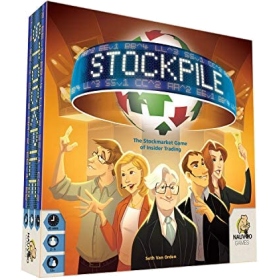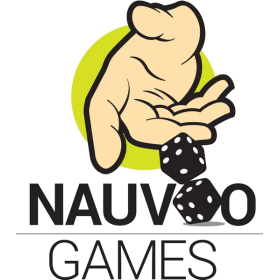Stockpile
 Stockpile is een economisch bordspel dat de traditionele aandelenstrategie van laag kopen, hoog verkopen combineert met verschillende extra mechanismen om een snelle, meeslepende en interactieve ervaring te creëren.
Stockpile is een economisch bordspel dat de traditionele aandelenstrategie van laag kopen, hoog verkopen combineert met verschillende extra mechanismen om een snelle, meeslepende en interactieve ervaring te creëren.
In Stockpile treden spelers op als beursbeleggers aan het einde van de 20e eeuw die hopen rijk te worden, en de belegger met het meeste geld aan het einde van het spel is de winnaar. Stockpile draait rond het idee dat niemand alles weet over de beurs, maar dat iedereen wel iets weet. In het spel manifesteert deze filosofie zich op twee manieren: insider informatie en de aanbodstapel.
Ten eerste krijgen de spelers elke ronde insider informatie. Deze informatie bepaalt hoe de aandelenkoers aan het einde van de ronde zal veranderen. Door onderhands te weten te komen of een aandeel zal stijgen of dalen, heeft elke speler een kans om de markt voor te zijn door op het juiste moment te kopen of te verkopen.
Ten tweede kopen de spelers hun aandelen door te bieden op stapels kaarten die aanbodstapels worden genoemd. Deze aanbodstapels bevatten een mix van open en gedekte kaarten die door andere spelers in het spel zijn geplaatst. Zo zal niemand alle kaarten in de aanbodstapels kennen. Ook zijn niet alle kaarten goed. Beurskosten kunnen de stapels vergiftigen door spelers meer te laten betalen dan ze bieden. Door aandelen en andere kaarten te veilen, katalyseert Stockpile spelersinteractie, vooral wanneer potentiële winsten uit insider informatie op het spel staan.
Beide mechanismen worden gecombineerd met enkele beurselementen om spelers meerdere factoren te doen overwegen bij het verkopen van een aandeel. Houd je een aandeel vast in de hoop een lucratieve aandelensplitsing binnen te halen of verkoop je nu om het mogelijke bankroet van het bedrijf te vermijden? Kun je je aandelen vasthouden tot het einde van het spel om de meerderheidsaandeelhouder te worden, of heb je de liquiditeit van cash nu nodig voor toekomstige biedingen? Riskeert je alles door zwaar te investeren in één bedrijf, of beperk je je risico door je portfolio te diversifiëren?
Uiteindelijk weet iedereen wel iets van de beurs, dus komt alles aan op de uitvoering van de strategie. Zul je de bewegingen van de aandelenmarkt met zekerheid kunnen trotseren? Of zullen je investeringen ten onder gaan aan slechte prognoses?
Aantal spelers: 2 - 5
Spelduur: 39 mn
Complexiteit: 2 / 5
Speel Stockpile en 1183 andere spellen online.
Geen download nodig - speel rechtstreeks in je webbrowser.
Met je vrienden en duizenden spelers van over de hele wereld.
Gratis.

Speel Stockpile en 1183 andere spellen online.
Geen download nodig - speel rechtstreeks in je webbrowser.
Met je vrienden en duizenden spelers van over de hele wereld.
Gratis.

Samenvatting van de regels
Overview
Stockpile is a fast-paced economic game of corporate investments, insider trading, and market manipulation. Each player acts as a private investor with the goal of amassing the greatest net worth. The player with the most money at the end of the game wins.
Playing The Game
Stockpile is played over 5-7 rounds, depending on the number of players. Each round consists of six phases:
- Information Phase
- Supply Phase
- Demand Phase
- Action Phase
- Selling Phase
- Movement Phase
During each phase, play begins with the player with the First Player Token and continues clockwise.
Information Phase
During the Information Phase, each player receives insider information in the form of a Company Card and a Forecast Card. Each player should look at their Company and Forecast Cards and keep them hidden from other players. The two cards are paired together to indicate a future change to a particular company's stock value. The actual change of the stock value takes place at the end of the round during the Movement Phase.
One pair of Company and Forecast Cards is public information (No public pairs exist in a 2P game). Both pairs of cards (the insider information and public information) should be used to make decisions during the Demand Phase and Selling Phase.
All 6 company's stock values will be impacted every round by a Forecast Card.
In the base game, the 6 Forecast Cards are all different. The Forecast Cards include: -3, -2, $$, +1, +2, +4. These values are also listed on the Player Board.
Supply Phase
One card is placed from the Market Deck face-up onto each Stockpile. These cards could be shares of company stock, trading fees, or action cards.
Each player is dealt two cards from the Market Deck.
In turn order, each player places one card face-up and one card facedown on the Stockpile(s) of their choice.
Demand Phase
Players take turns bidding on Stockpiles until each Stockpile has only one Bidding Meeple on it.
Players pay their bids, collect all cards, and pay any trading fees. Trading fees range between $1,000 - $3,000.
Stock cards are kept hidden in a player's stock portfolio.
Action Phase
In turn order, players use all Action Cards acquired during the Demand Phase. Action Cards may move a stock's value by +2 or -2.
Selling Phase
In turn order, players may sell any number of stocks that they own and receive money from the supply equal to their current value. When selling a split stock, you may choose to sell one or both of its shares.
Movement Phase
All pairs of Company Cards and Forecast Cards are revealed and the stock values move accordingly, taking into account stock splits and bankruptcy.
- Stock Split - If a stock’s value ever increases to more than 10, the stock splits. A stock split effectively doubles your existing shares for that stock. When a stock splits, all players who have stock of that type in their portfolio will reveal it and move it to their Split Portfolio face-down. If the increase causes the stock’s value to land exactly on the Stock Split space, then the value of the stock returns to 6. If the stock’s increase would move the value further than the Stock Split space, reset the value of the stock to 6 and continue to increase the stock’s value.
- IMPORTANT: Any new stock obtained after the stock split goes in a player’s regular Stock Portfolio, not the Split Portfolio. If a player already owns a stock in his Split Portfolio and that stock splits again later in the game, then that player receives $10,000 in Currency Cards for each Stock Card of that type in their Split Portfolio. The stock then remains in the Split Portfolio.
- Bankruptcy - If a stock’s value ever moves below 1 on a turn, it immediately goes bankrupt. All players discard all stock of that kind that they own, including any stocks in their Split Portfolio. Return the stock’s price to the starting value of 5.
The Forecast Cards with $$ indicates a $2,000 dividend for each share that a player owns and elects to show.
Round End
Advance the Round Marker and pass the First Player Token clockwise to the next player.
Game End
At the end of the game, players will reveal all of the stock cards in their portfolio and perform the following steps:
- Determine majority shareholders. A majority shareholder is the player with the most stock in any company. The majority shareholders of each company receive a bonus of $10,000. If there is a tie, all tied players receive $5,000. Reminder: Shares in player’s Split Portfolios count as double when determining majority shareholders.
- Sell all stock at final values. Each player then sells their shares to the bank at a price equal to the final value of the stock. Reminder: Any shares in players’ Split Portfolios count as double.
- Total each player’s currency. Add up each player’s money, including any Currency Cards on hand.
The player(s) with the most money wins.
2P Variant
It's suggested to play Stockpile at least once with more than two players before trying the 2-Player Variant. The 2-player variant plays similar to a 4-player game. However, there a few changes to the round’s phases. These can be round in the rules here: https://boardgamearena.com/gamepanel?game=stockpile

